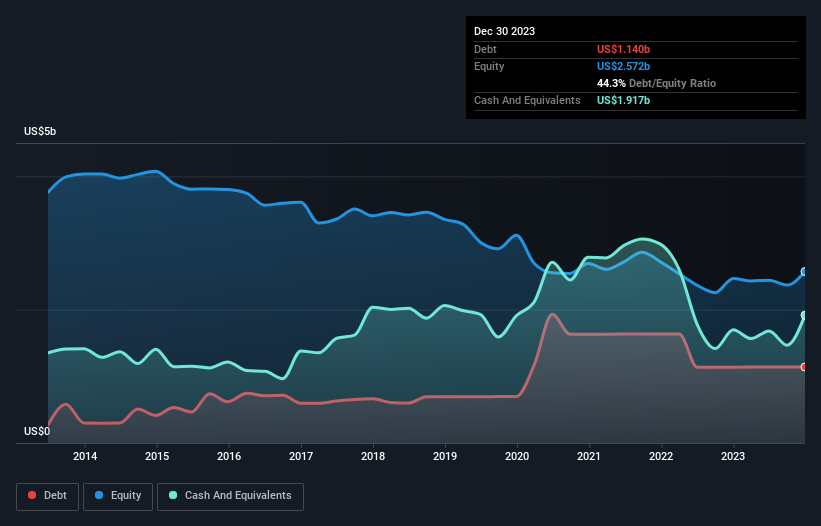
Howard Marks put it nicely when he said that, rather than worrying about share price volatility, 'The possibility of permanent loss is the risk I worry about... and every practical investor I know worries about.' So it seems the smart money knows that debt - which is usually involved in bankruptcies - is a very important factor, when you assess how risky a company is. Importantly, Ralph Lauren Corporation (NYSE:RL) does carry debt. But is this debt a concern to shareholders?
What Risk Does Debt Bring?
Generally speaking, debt only becomes a real problem when a company can't easily pay it off, either by raising capital or with its own cash flow. Ultimately, if the company can't fulfill its legal obligations to repay debt, shareholders could walk away with nothing. While that is not too common, we often do see indebted companies permanently diluting shareholders because lenders force them to raise capital at a distressed price. Of course, debt can be an important tool in businesses, particularly capital heavy businesses. The first step when considering a company's debt levels is to consider its cash and debt together.
Check out our latest analysis for Ralph Lauren
What Is Ralph Lauren's Debt?
As you can see below, Ralph Lauren had US$1.14b of debt, at December 2023, which is about the same as the year before. You can click the chart for greater detail. However, it does have US$1.92b in cash offsetting this, leading to net cash of US$777.4m.

How Strong Is Ralph Lauren's Balance Sheet?
Zooming in on the latest balance sheet data, we can see that Ralph Lauren had liabilities of US$1.68b due within 12 months and liabilities of US$2.75b due beyond that. Offsetting these obligations, it had cash of US$1.92b as well as receivables valued at US$527.4m due within 12 months. So its liabilities outweigh the sum of its cash and (near-term) receivables by US$1.99b.
Since publicly traded Ralph Lauren shares are worth a very impressive total of US$11.0b, it seems unlikely that this level of liabilities would be a major threat. But there are sufficient liabilities that we would certainly recommend shareholders continue to monitor the balance sheet, going forward. Despite its noteworthy liabilities, Ralph Lauren boasts net cash, so it's fair to say it does not have a heavy debt load!
The good news is that Ralph Lauren has increased its EBIT by 3.2% over twelve months, which should ease any concerns about debt repayment. There's no doubt that we learn most about debt from the balance sheet. But ultimately the future profitability of the business will decide if Ralph Lauren can strengthen its balance sheet over time. So if you're focused on the future you can check out this free report showing analyst profit forecasts.
Finally, a company can only pay off debt with cold hard cash, not accounting profits. Ralph Lauren may have net cash on the balance sheet, but it is still interesting to look at how well the business converts its earnings before interest and tax (EBIT) to free cash flow, because that will influence both its need for, and its capacity to manage debt. Over the most recent three years, Ralph Lauren recorded free cash flow worth 70% of its EBIT, which is around normal, given free cash flow excludes interest and tax. This cold hard cash means it can reduce its debt when it wants to.
Summing Up
While Ralph Lauren does have more liabilities than liquid assets, it also has net cash of US$777.4m. The cherry on top was that in converted 70% of that EBIT to free cash flow, bringing in US$776m. So is Ralph Lauren's debt a risk? It doesn't seem so to us. The balance sheet is clearly the area to focus on when you are analysing debt. But ultimately, every company can contain risks that exist outside of the balance sheet. These risks can be hard to spot. Every company has them, and we've spotted 1 warning sign for Ralph Lauren you should know about.
Of course, if you're the type of investor who prefers buying stocks without the burden of debt, then don't hesitate to discover our exclusive list of net cash growth stocks, today.
New: AI Stock Screener & Alerts
Our new AI Stock Screener scans the market every day to uncover opportunities.
• Dividend Powerhouses (3%+ Yield)
• Undervalued Small Caps with Insider Buying
• High growth Tech and AI Companies
Or build your own from over 50 metrics.
Have feedback on this article? Concerned about the content? Get in touch with us directly. Alternatively, email editorial-team (at) simplywallst.com.
This article by Simply Wall St is general in nature. We provide commentary based on historical data and analyst forecasts only using an unbiased methodology and our articles are not intended to be financial advice. It does not constitute a recommendation to buy or sell any stock, and does not take account of your objectives, or your financial situation. We aim to bring you long-term focused analysis driven by fundamental data. Note that our analysis may not factor in the latest price-sensitive company announcements or qualitative material. Simply Wall St has no position in any stocks mentioned.
About NYSE:RL
Ralph Lauren
Designs, markets, and distributes lifestyle products in North America, Europe, Asia, and internationally.
Outstanding track record with excellent balance sheet.


